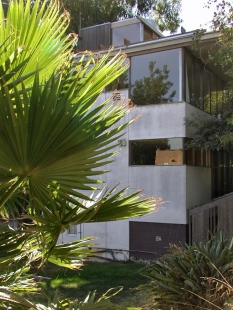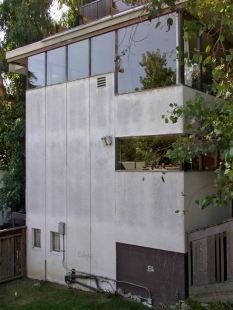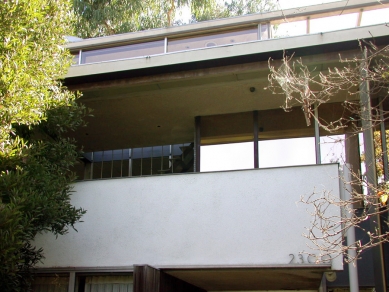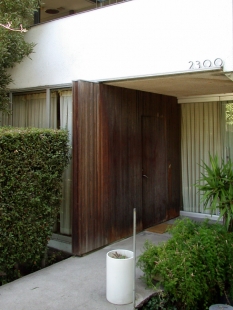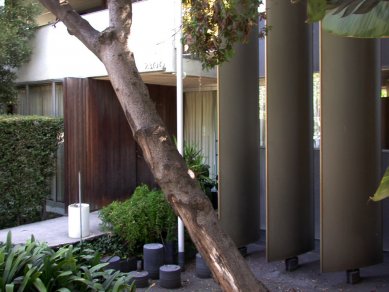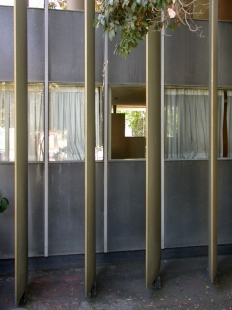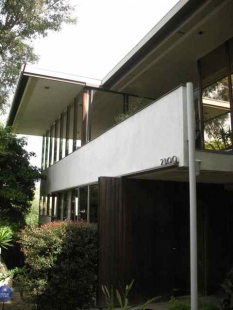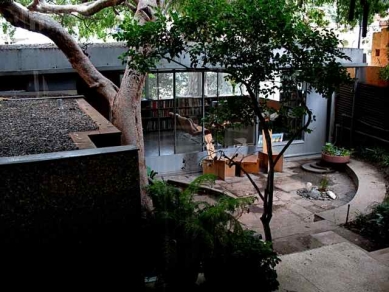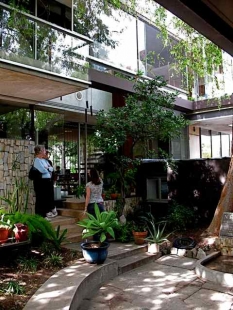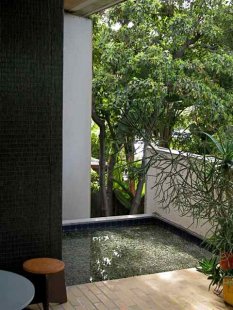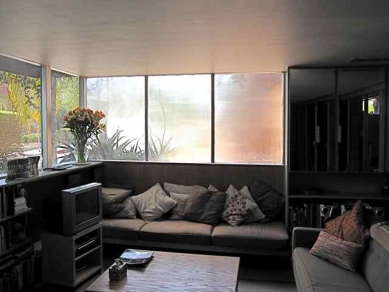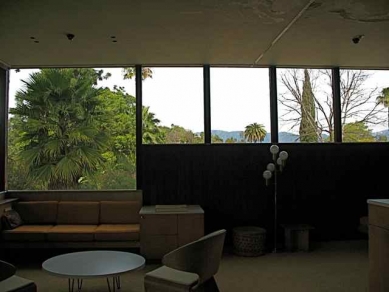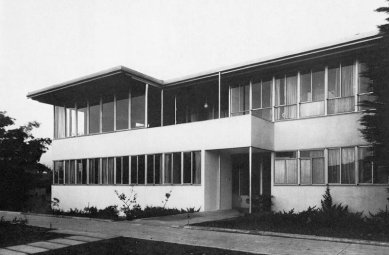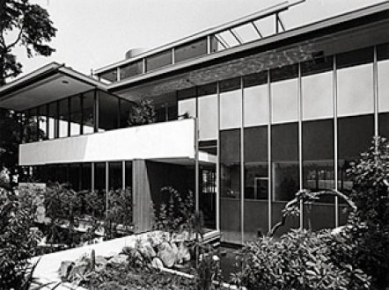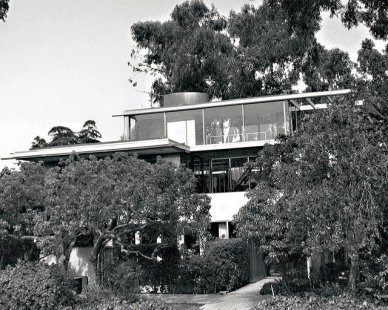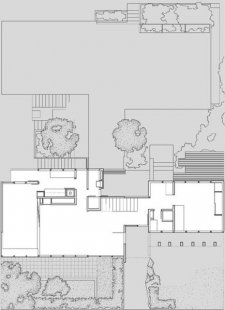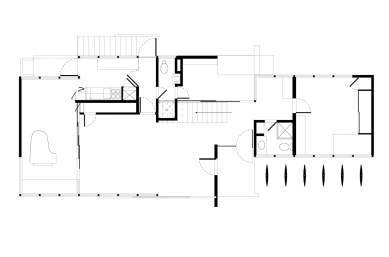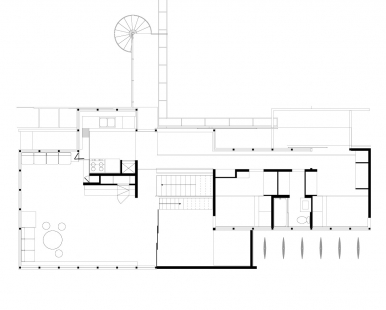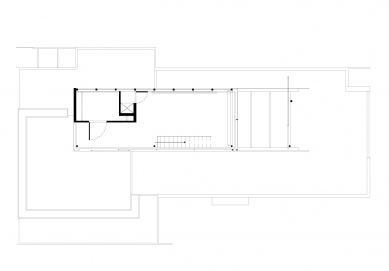
Richard Neutra's private house with studio
Neutra VDL Studio and Residences

On Wednesday, July 2, 2014, the youngest son of Richard Neutra arrived in Brno to present one of the key Californian projects of this Vienna-born architect in the living room of the Tugendhat villa. In his opening remarks, Vladimír Šlapeta described Richard Neutra's personality and his relationship with former Czechoslovakia. During his studies at the Vienna University of Technology, Neutra experienced the dissolution of the monarchy, the advancement of civilization into the 20th century, and the rise of modernism. He managed to be a pupil of Loos, an assistant to Mendelsohn, a collaborator with Wright, a subtenant of Schindler, and a co-founder of the Los Angeles Academy of Modern Arts. He had the opportunity to meet masters of the old era such as Sullivan or Holabird, maintained intense contacts with the interwar European avant-garde, and was part of the experimental program Case Study Houses in post-war America.
At the invitation of the Šlapeta brothers, Richard Neutra, along with his wife, came to give a lecture in Prague in 1963 (he later visited Czechoslovakia twice more, and in 1969 the Neutras stayed at the International Hotel in Brno). During his first visit to Czechoslovakia, their own house also caught fire, which was to be the subject of a lecture by Raymond Neutra, who unexpectedly chose a professional career as a doctor. He easily convinced us that even his father tried to heal people with his buildings and that Raymond now attempts to restore his father's buildings through renovations. The experimental VDL house, which accommodated three families and also served as Neutra's office, had to have a significant impact on Raymond. From a young age, he helped his father sort projects and assisted photographer Julius Shulman. Although he is not an architect himself, he learned many things from his father that have proven useful in biology and sociology.
Neutra's California studio on the shores of Silver Lake was meant to be exemplary and clearly reflect what a healthy lifestyle should look like. In the first phase, the house occupied 254 m², while in 1940, an additional 84 m² were added, and following a devastating fire in 1963, the house underwent significant reconstruction.
The VDL studio is named after the Dutch industrialist and philanthropist Cornelius Hendrik van der Leeuw, who, although he was not an architect himself, occupies an important place in the history of 20th-century Dutch architecture. In 1917, Leeuw became a partner in the family firm Van Nelle, which traded in coffee, tea, and tobacco. However, he was a person with broad interests and horizons. Thus, in 1931 he decided to study under Sigmund Freud in Vienna, where he obtained his doctorate in psychiatry in 1939. After the annexation of Austria, he returned to the Netherlands, where he was commissioned by the minister to develop a reconstruction plan for Rotterdam shortly after the war, subsequently becoming a curator at the TU in Delft, where he organized architectural lectures and later led the board of the Kröller-Müller foundation.
The first meeting between Neutra and Van der Leeuw took place in 1930 in Basel, where he accepted an invitation to see the newly completed family factory Van Nelle in the Netherlands. At the same time, he thoroughly got to know the Dutch scene, which had already been able to fulfill the ideas of American architect Frank Lloyd Wright even before the First World War.
Neutra's second meeting with Van der Leeuw took place in New York, when he received a check worth $3,000 for the realization of an experimental house in California. With Leeuw's help, Neutra aimed to achieve the industrialization of house production and make quality housing accessible to a broader range of buyers. Neutra desired to reach out to large companies that could produce entire houses cheaply and efficiently, similar to Ford's factory. American visionary Buckminster Fuller and French engineer Jean Prouvé had similar ambitions, but in the end, people favored the offer of the "inventor of suburbs," William J. Levitt.
Although Studio VDL was created in the 1930s, it raises questions that are valid even today. It seeks a balance between appropriate consumption of space, materials, and labor. The house has undergone a number of modifications, changes in the use of existing rooms, and the addition of a new wing. Within the house, there are numerous references that Neutra drew upon throughout his life. From Loos's relationship with windows and the way of working with space to Moorish and Japanese conceptions of intimate atriums, to phenomenological perceptions of spaces regardless of how the house looks, but rather what one feels within it through other senses.
In 2008, the house underwent its last major reconstruction, during which the roof was repaired thanks to an auction of Shulman's photographs. Currently, the house is rented for commercial events, but it also continues to educate, collaborates with universities, hosts artists, and strives to fulfill Richard Neutra's legacy.
At the invitation of the Šlapeta brothers, Richard Neutra, along with his wife, came to give a lecture in Prague in 1963 (he later visited Czechoslovakia twice more, and in 1969 the Neutras stayed at the International Hotel in Brno). During his first visit to Czechoslovakia, their own house also caught fire, which was to be the subject of a lecture by Raymond Neutra, who unexpectedly chose a professional career as a doctor. He easily convinced us that even his father tried to heal people with his buildings and that Raymond now attempts to restore his father's buildings through renovations. The experimental VDL house, which accommodated three families and also served as Neutra's office, had to have a significant impact on Raymond. From a young age, he helped his father sort projects and assisted photographer Julius Shulman. Although he is not an architect himself, he learned many things from his father that have proven useful in biology and sociology.
Neutra's California studio on the shores of Silver Lake was meant to be exemplary and clearly reflect what a healthy lifestyle should look like. In the first phase, the house occupied 254 m², while in 1940, an additional 84 m² were added, and following a devastating fire in 1963, the house underwent significant reconstruction.
The VDL studio is named after the Dutch industrialist and philanthropist Cornelius Hendrik van der Leeuw, who, although he was not an architect himself, occupies an important place in the history of 20th-century Dutch architecture. In 1917, Leeuw became a partner in the family firm Van Nelle, which traded in coffee, tea, and tobacco. However, he was a person with broad interests and horizons. Thus, in 1931 he decided to study under Sigmund Freud in Vienna, where he obtained his doctorate in psychiatry in 1939. After the annexation of Austria, he returned to the Netherlands, where he was commissioned by the minister to develop a reconstruction plan for Rotterdam shortly after the war, subsequently becoming a curator at the TU in Delft, where he organized architectural lectures and later led the board of the Kröller-Müller foundation.
The first meeting between Neutra and Van der Leeuw took place in 1930 in Basel, where he accepted an invitation to see the newly completed family factory Van Nelle in the Netherlands. At the same time, he thoroughly got to know the Dutch scene, which had already been able to fulfill the ideas of American architect Frank Lloyd Wright even before the First World War.
Neutra's second meeting with Van der Leeuw took place in New York, when he received a check worth $3,000 for the realization of an experimental house in California. With Leeuw's help, Neutra aimed to achieve the industrialization of house production and make quality housing accessible to a broader range of buyers. Neutra desired to reach out to large companies that could produce entire houses cheaply and efficiently, similar to Ford's factory. American visionary Buckminster Fuller and French engineer Jean Prouvé had similar ambitions, but in the end, people favored the offer of the "inventor of suburbs," William J. Levitt.
Although Studio VDL was created in the 1930s, it raises questions that are valid even today. It seeks a balance between appropriate consumption of space, materials, and labor. The house has undergone a number of modifications, changes in the use of existing rooms, and the addition of a new wing. Within the house, there are numerous references that Neutra drew upon throughout his life. From Loos's relationship with windows and the way of working with space to Moorish and Japanese conceptions of intimate atriums, to phenomenological perceptions of spaces regardless of how the house looks, but rather what one feels within it through other senses.
In 2008, the house underwent its last major reconstruction, during which the roof was repaired thanks to an auction of Shulman's photographs. Currently, the house is rented for commercial events, but it also continues to educate, collaborates with universities, hosts artists, and strives to fulfill Richard Neutra's legacy.
The English translation is powered by AI tool. Switch to Czech to view the original text source.
0 comments
add comment


